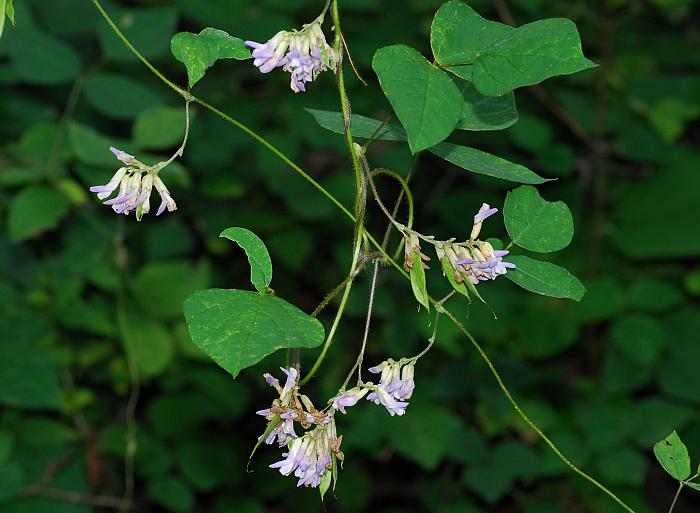Amphicarpaea bracteata (L.) Fernald
Hog Peanut

Native
CC = 4
CW = 0
MOC = 79
© SRTurner
Amphicarpaea bracteata (L.) FernaldHog Peanut | |
 |
Native CC = 4 CW = 0 MOC = 79 |
© SRTurner |
|
Family - Fabaceae/Faboideae Habit - Taprooted annual, climbing on other vegetation. Stems - Twining, to 2 m, herbaceous, glabrous to densely pubescent with antrorse to spreading hairs.
Leaves - Alternate, pinnately trifoliolate, petiolate. Petiole to 5 cm long, hairy. Stipules ovate, membranous, to 5 mm long. Leaflets ovate to rhombic, variously pubescent, entire, to 10 cm long, usually bluntly pointed, often asymetrical at base, the stipels deciduous, 1-2 mm long. Stalk of center leaflet much longer than those of lateral leaflets.
Inflorescence - Pendant, axillary racemes.
Flowers - Chasmogamous flowers to 1.5 cm long, papilionaceous. Corolla purplish to white. Stamens diadelphous. Calyx of 5 sepals united more than half there length, upper two sepals united for entire length creating a 4-lobed calyx to 5 mm long.
Fruits - (Of chasmogamous flowers) - To 4 cm long, flattened, with 2-4 seeds, oblong-linear. Fruits (of cleistogamous flowers) - 1 seeded, pyriform.
Flowering - August - October. Habitat - Open woods, thickets, moist slopes. Lookalikes - None close. Origin - Native to tropical America. Also cultivated. Lookalikes - Vegetatively similar to species of Strophostyles. Other info. - Steyermark listed two varieties for this species: var. comosa, having larger leaves and dense pubescence, and var. bracteata, having the opposing characters. Yatskievych did not formally accept this division, citing free intergradation, absence of geographical correlation, and frequent mixed populations. However, he also made note of some genetic basis for the distinction and stated the need for further work in the area. Photographs taken in Brown Summit, NC., 9-8-02 (DETenaglia); also at Victoria Glade, Jefferson County, MO, 8-30-2015; Lost Creek Conservation Area, Warren County, MO, 9-6-2016; along the Katy Trail near Dutzow, 9-19-2019 and 10-17-2019, and along the Al Foster Trail near Glencoe, St. Louis County, MO, 9-9-2021 (SRTurner). |